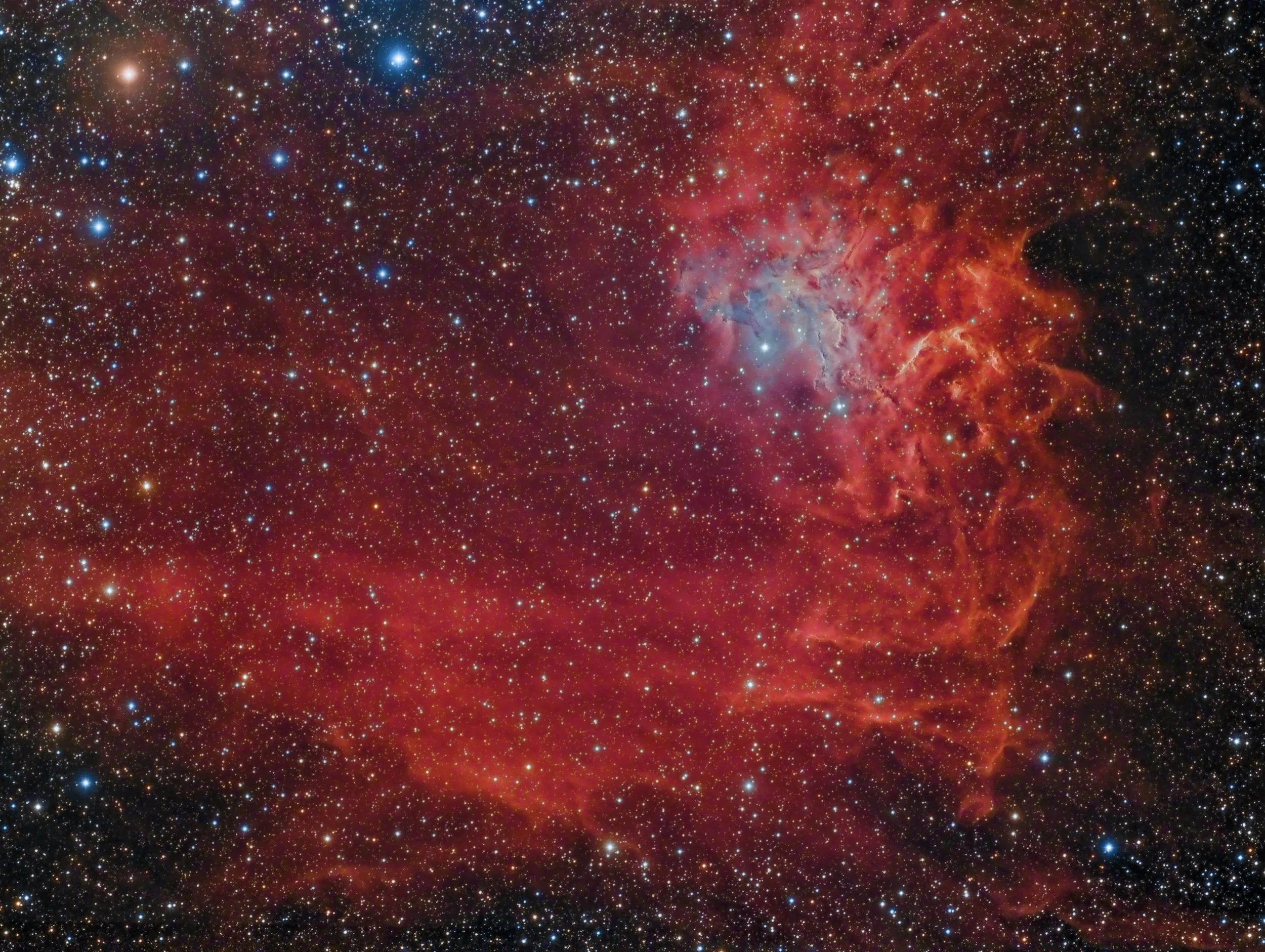
AAPOD2 Image Archives
Flaming Star Nebula in SHO
Image Description and Details :
Imaging telescopes or lenses: Skywatcher 130PDSImaging cameras: ZWO ASI294MM ProMounts: Synta Sky-Watcher EQ6-r PROGuiding telescopes or lenses: Artesky 70/400 mmGuiding cameras: ZWO ASI290MM MiniFocal reducers: Sky-Watcher Coma corrector 0.9xSoftware: N.I.N.A. Nighttime Imaging 'N' Astronomy · Astro Pixel Processor · PixInshight · PHD2Filters: Astronomik 31mm 6nm SII Astronomik 6nm SII · Astronomik 31mm 6nm OIII Astronomik 6nm OIII · Astronomik 31mm 6nm Ha Astronomik 6nm HaAccessory: Pegasus power box micro · ZWO Off-Axis Guider · ASI ZWO EAF (Electronic Automatic Focuser) · ZWO 8x 1.25" Filter Wheel (EFW) ZWO 8X EFWDates:24 Nov 2021 , 25 Nov 2021 , 3 Dec 2021Frames:Astronomik 31mm 6nm Ha Astronomik 6nm Ha: 57x300" (4h 45') (gain: 120.00) -10C bin 2x2Astronomik 31mm 6nm OIII Astronomik 6nm OIII: 22x300" (1h 50') (gain: 120.00) -10C bin 2x2Astronomik 31mm 6nm SII Astronomik 6nm SII: 48x300" (4h) (gain: 120.00) -10C bin 2x2Integration: 10h 35'Darks: 30Flats: 20Flat darks: 20Avg. Moon age: 22.72 daysAvg. Moon phase: 49.61%Bortle Dark-Sky Scale: 5.00Mean SQM: 20.25Temperature: -3.67
Copyright: Sorin Crisan
IC 405 - FLAMING STAR NEBULA
Image Description and Details : Telescope: FSQ-106ED
Camera: QSI 583ws
Guide: EZG-60 - ZWO ASI 120 MC
Filters: BAADER LRGB, ASTRONOMIK H-ALPHA
Exposure: 42 x 10 MIN LUM, 11 X 5 MIN RED B2, 11 X 5 MIN GREEN B2, 11 X 5 MIN BLUE B2,10 X 10 MIN H-ALPHA
Software: MAXIM DL, PHOTOSHOP CC, PIXINSIGHT
Location: ESCOBAR DE CAMPOS, LEON (SPAIN)
Copyright: César Blanco
flame star IC405 to the ′′ pond ′′ IC410,
From the flame star IC405 to the ′′ pond ′′ IC410, the celestial area in the Giffus is filled with ionized aluminum clouds, the original tone is dominated by red -- until a comet, C / 2020 M3 ATLAS, Dragging the short tail to break into here, bringing a piece of green.
In order to shoot the comet, QHY268C was specially adjusted to high gain mode, Gain 56, Offset 10, with a 100-second short exposure to prevent the comet from dragging. As a result, the comet was captured, but the camera hung up, the infinite card read out, and had to return to the factory for repair. Now, even the equatorial meter is starting to go crazy for unknown reasons.
It seems that the comet is really a broom star......
Location: Hebei Kangbo Galaxy Observatory
Taken on December 9-10, 2020
Telescope: 150 2.8 HNT
Camera: QHY268c
Equator: Eaton iOptron CEM70
Guide: QHYCCD OAG-M
Guide Star Camera: QHY5L-II-M
Number of sheets taken: 206
Single exposure: 100 seconds
Cumulative exposure: 5.7 hours
APT: APT
PixInsight, PhotoShop
Copyright: Steed Yu
IC 405 (Caldwell31)
IC 405 (Caldwell31) is a diffuse nebula visible in the constellation of Auriga, located at 1630 light years from Earth. In its direction you can see AE Aurigae, a variable and mysterious star, according to some studies it would be a star born in the region of the Orion Nebula about 2.7 million years ago and then moved to the Milky Way from there.
IC 405 shines with the radiation received from AE Aurigae, which ionizes its gases (mainly hydrogen) and gives it a red color; the blue patches are instead due to the reflection of the blue light of the star on the dark dust. IC 405 appears to be connected with other nebulosity systems, in particular with IC 410, visible one degree to the southeast; in reality they are much more distant objects.





